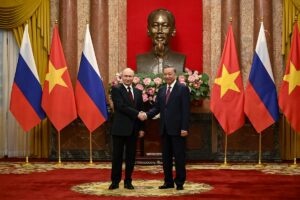Thailand’s Board of Investment has approved the country’s next Five-Year Investment Promotion Strategy.
The strategy aims to identify industries and sectors that are essential to Thailand’s long-term development and competitiveness. The strategy will take effect at the start of 2023 and run through 2027.
Thailand has adopted a new five-year investment promotion strategy, highlighting the country’s efforts to attract investment in innovative, high-tech, and green industries.
Thailand’s Board of Investment (BOI) announced that it approved the new Five-Year Investment Promotion Strategy which identifies industries and sectors that are strategic to Thailand’s long-term development and competitiveness. The strategy will be in effect between 2023 and 2027.
BOI will create supportive policies and services to encourage both domestic and foreign investment in these industries.
Restructuring the national economy
The BOI’s investment promotion strategy carries an overarching theme of moving Thailand into “the new economy era”. This concept broadly aligns with Industry 4.0, which refers to the application of automation, artificial intelligence, and smart technology in the economy.
The strategy states that the restructuring of Thailand’s economy to the new economy era will follow three core concepts. These are:
- Innovation, technology, and creativity;
- Competitiveness and the ability to adapt quickly; and
- Inclusiveness, taking into account environmental and social sustainability.
These concepts do not refer to specific issues or industries. Rather, they are principles to guide how Thailand should develop all facets of the new economy. Further, it seeks to strengthen Thailand’s status as a regional hub for business, trade, and logistics.
The strategy’s seven pillars
The strategy lists seven pillars for expressing the BOI’s investment promotion policies and turning the strategy’s vision into reality. These are the concrete areas of industry development and policy reforms identified by the strategy.
The strategy’s seven pillars are as follows:
- The upgrade of existing industries, in parallel with the building of new industries in which Thailand has a high potential, and an overall strengthening of the supply chain.
- The acceleration of the industrial transition to green and smart industries through investments in automation, digital adoption, and decarbonization.
- The promotion of Thailand as a business center, and an international trade and investment gateway for the region.
- The strengthening of SMEs and startups, ensuring they are connected to the global market and supply chain.
- The promotion of investments in the different regions of Thailand fits the potential of each area and enables inclusive growth.
- The promotion of investments that will promote community and social development.
- The promotion of Thailand’s overseas investment to expand business opportunities for Thai companies.
The seven pillars strike a number of shared themes. Areas highlighted across the pillars include the need to digitize the economy, create green industries and processes, and promote inclusive growth across Thailand’s regions and communities.
Industries that stand to benefit under these pillars include electric vehicle manufacturers, bio-circular green (BCG) industries, and automated manufacturing systems, among others. Further, Thailand will put increased focus on developing innovation and R&D capabilities, as well as a stronger knowledge-based economy.
The BOI will promote these seven pillars through a combination of incentives, service support, and policies that improve the business environment. According to Narit Therdsteerasukdi, the Secretary General of the BOI, “the BOI will broaden its role from that of a ‘Promoter’ providing tax and non-tax benefits, to focus on becoming an ‘Integrator’ of investment support tools, a ‘Facilitator’ providing services, and a ‘Connector’ linking industries to create more business opportunities.”
This statement suggests that over the next five years, the BOI will put greater emphasis on increasing support for both domestic and foreign investors by improving Thailand’s business environment and ease of doing business. At the same time, Thailand will continue to offer tax benefits and other incentives to encourage investment in target industries and regions.
Thailand’s investment trends in 2022
Alongside the release of the investment promotion strategy, the BOI released Thailand’s investment statistics through the first nine months of 2022. The statistics show that investment in Thailand has been relatively resilient this year, but foreign investment has lagged. Further, while there is strong growth in the number of investments, the average size of each investment is smaller.
From January to the end of September, Thailand had 1,247 applications for investment promotion filed with the BOI, an 8.5 percent increase year-on-year.
These investments, which came from both domestic and foreign investors, were worth a combined THB 439.1 billion (US$11.44 billion), a decrease of 14.1 percent from the same period a year earlier.
Foreign direct investment (FDI) into Thailand has been weak through the first nine months of the year. FDI applications decreased by 25 percent year-on-year and were worth a combined total of THB 275.6 billion (US$7.18 billion).
The largest sources of FDI during this period were China (THB 45 billion/US$1.17 billion), Taiwan (THB 39.3 billion/US$1.02 billion), Japan (THB 37.6 billion/US$980 million), the U.S. (THB 34.3 billion/US$890 million), and Hong Kong (THB 26.3 billion/US$690 million).
While FDI in Thailand has lagged this year, some areas have continued to perform strongly. Thailand’s Eastern Economic Corridor (EEC) continues to be popular among investors, receiving THB 246.7 billion (US$6.43 billion) in investments, representing 56 percent of total investments into Thailand by value. The EEC is an area that includes three of Thailand’s eastern provinces that the government is promoting as a regional hub for trade, investment, and logistics.
Further, Thailand attracted THB 286.7 billion (US$7.47 billion) in investments in targeted industries. These were led by automotive and parts (THB 79.4 billion/US$2.07 billion), electrical appliances and electronics (THB 60.8 billion/US$1.58 billion), and agriculture and food processing (THB 54.7 billion/US$1.43 billion).
Investment trends in Thailand reflect an international economic environment grappling with inflation, decreased demand, supply chain constraints, and slowing growth in China, one of Thailand’s most important economic partners. Thailand’s new five-year investment promotion strategy is unlikely to reverse these trends in the short term but stands to strengthen the country’s economic resilience if implemented properly.
Foreign investors can expect more information on specific incentives and supportive policies created as part of the strategy in the weeks and months ahead.
Source: Asean Briefing















